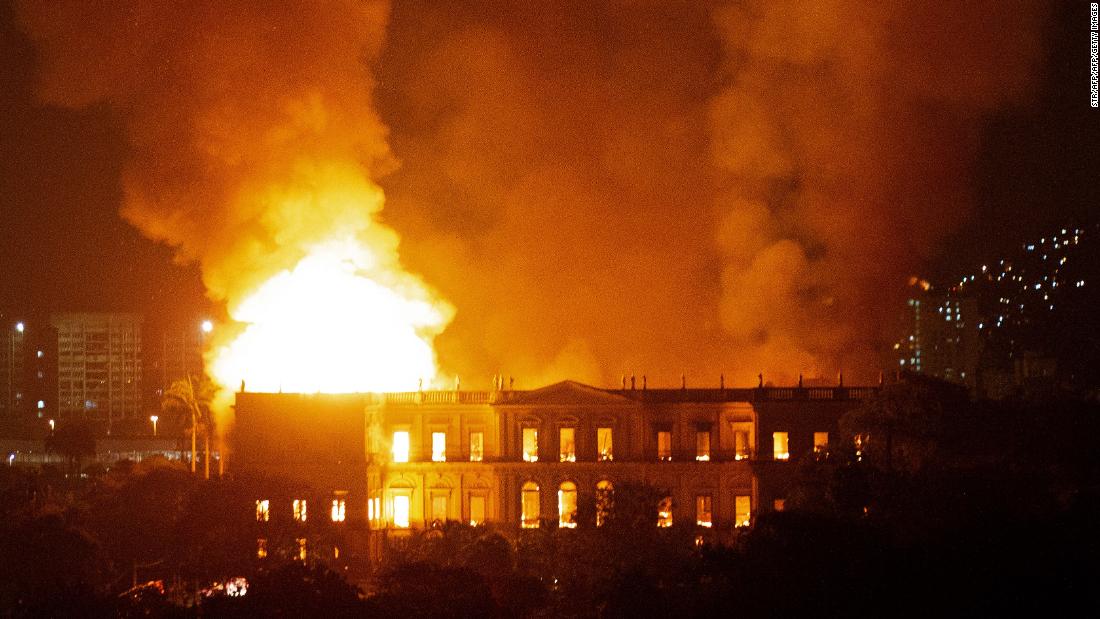This past Sunday Brazil's 200 year old National Museum was involved in a massive fire and it appears much of the 20 million objects in the collection have been lost.
The NY Times reports
Source: The NY TimesIn the months and years before Brazil’s National Museum was consumed by fire on Sunday, federal prosecutors, researchers and even the museum’s own administration warned that neglect had turned the 200-year-old institution into a tinderbox.
On Tuesday, evidence of this disregard came to light even as workers sifted through what little is left of the 20-million-item collection. The devastation has come to symbolize what many Brazilians see as a nation in disrepair because of widespread corruption and a wholesale decline in government services.
“We knew that the fire one day was bound to happen,” said Marcelo Weksler, a curator of the mammals exhibit. “Everybody here knew that. It was our worst nightmare.”
A citizen’s complaint, filed with the federal prosecutor’s office in Rio de Janeiro by an architect on July 27, included photos and pointed to specific hazards like the use of flammable plastic on the roof, uncovered wires and other evidence of jury-rigged wiring.
The museum administration denied those claims.
“This unique collection in Brazil can catch fire at any moment, and it is a miracle it hasn’t happened yet,” the author of the complaint, whose name was not released by the prosecutor’s office, wrote. “An inspection by the fire department is urgent!”
Prosecutors followed up, notifying the Federal University of Rio de Janeiro, which runs the museum, and two different federal government agencies of the risk exactly one month before the fire happened.
There was no immediate action, and this was only the most recent warning.
In 2015, museum officials asked Brazil’s National Development Bank for a loan to improve infrastructure. Negotiations over the project and the amount of resources it needed stretched for almost three years, said the museum’s director, Alexander Kellner.
According to the bank, one request was sent back after the bank’s technical staff noticed the proposal requested funding to draw up a fire-suppression plan, but not to install the system.
On the bank’s advice, and after an offer of more resources, the request was rewritten to include the installation of an adequate fire safety system, as well as other improvements such as fixing the museum’s electric infrastructure. That proposal was approved, and money was finally disbursed in June.
As evidence of lax oversight surfaces, so does recrimination between the public institutions responsible for the museum’s administration and maintenance. Accused of poor management, university and museum officials point to their budgets, which have been severely slashed by the federal government in the last four years as Brazil faced a stifling recession.
“The government prefers to invest in some things and not others,” said Mr. Kellner, pointing to Rio’s Maracana soccer stadium, which underwent a $540 million renovation before the 2014 World Cup.
“You can’t blame one person specifically” for the fire, he said, pointing out that when firefighters responded, they found the fire hydrants in front of the museum dry and had to use water from a nearby lake to fight the flames.
But other evidence suggests the neglect was chronic. In the fire’s aftermath, local media outlets scoured their archives, finding reports dating to the 1950s that a tragedy was imminent.
The museum is “an easy target for a fire,” said one 1978 headline in the newspaper O Globo. In May 2004, Sérgio Alex Azevedo, then the museum’s director, said the museum didn’t have a fire-suppression system, “just a couple fire extinguishers.”
A handout issued by the university’s rector, Roberto Leher, mentioned improvements that were being implemented and stressed the institution’s lack of funding. To him, the main cause of the tragedy was a set of government priorities “that reduces our memory to ashes.”
On Monday, as he spoke to the news media, Mr. Kellner acknowledged the importance of accountability. Even as he fended off questions about what was left of the museum’s collection, he asked society to press the authorities — including himself — for answers.
“It’s right to ask about what was lost,” he said. “Society has the right to know. Call for it! Demand it from us.”


No comments:
Post a Comment